1993 CHEVROLET CAVALIER washer fluid
[x] Cancel search: washer fluidPage 86 of 308
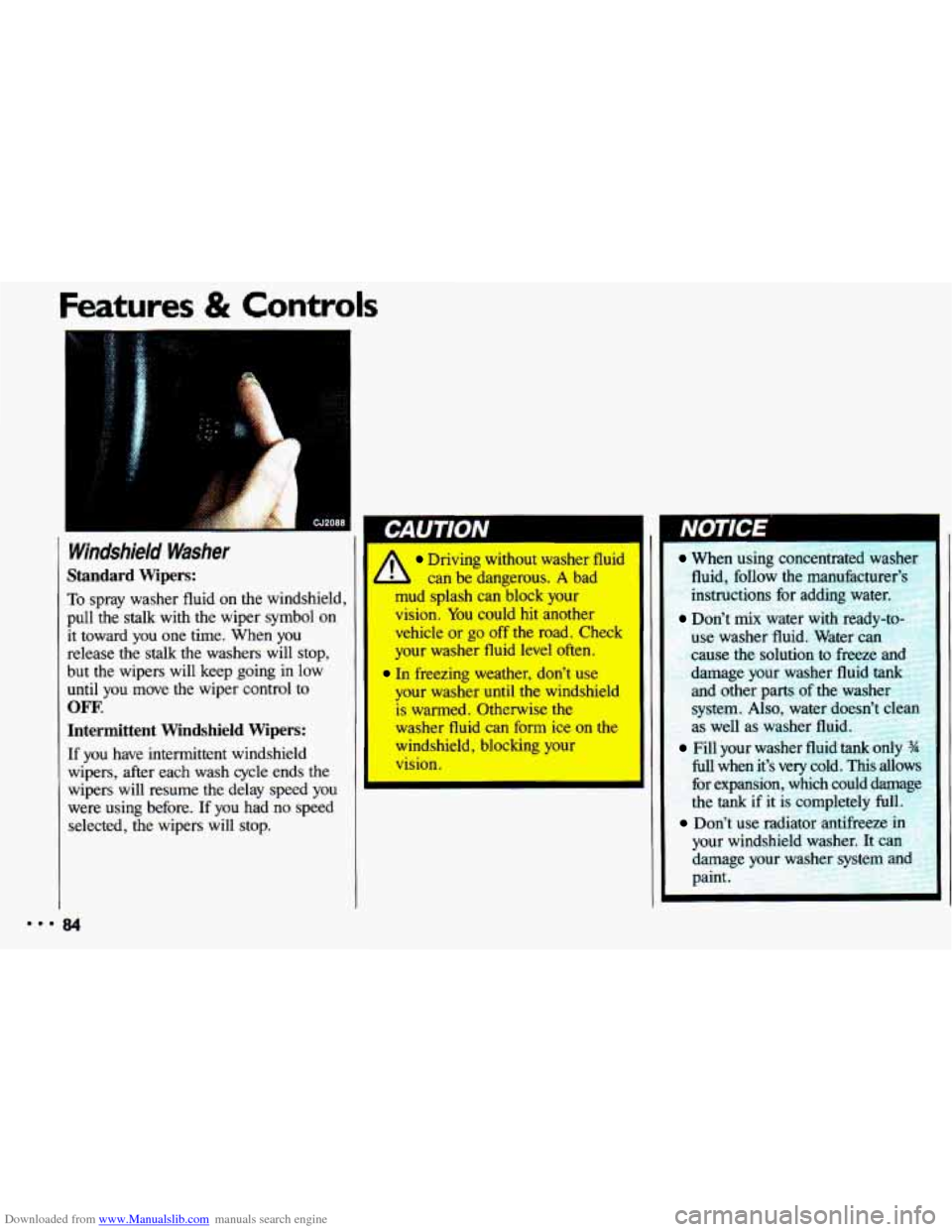
Downloaded from www.Manualslib.com manuals search engine Features & Controls
Windshield Washer
Standard Wipers:
To spray washer fluid on the windshield,
pull the stalk with the wiper symbol on
it toward you one time. When you
release the stalk the washers will stop,
but the wipers will keep going in low
until you move the wiper control to
OFF.
Intermittent Windshield Wipers:
If you have intermittent windshield
wipers, after each wash cycle ends the
wipers will resume the delay speed you were using before. If you had
no speed
selected, the wipers will stop.
I
Driving without washer fluid
A can be dangerous. A bad
mud splash can block your
vision.
You could hit another
vehicle
or go off the road. Check
your washer fluid level often.
In freezing weather, don’t use
your washer until the windshield is warmed. Otherwise the
washer fluid can form ice on the
windshield, blocking your
vision.
When using concentrated washer fluid, follow the manufacture]
instructions for adding
wa
Don’t mix water with readv-
use washer fluid. Water c;
cause the solution
to freeze E
damage your washer fluid tank
and other parts of the washer
system.
Also, water doesn’t cle:
as well as washer fluid.
Fill your washer fluid tank omy
hll when it’s very cold, This allows
for expansion, which could damage
the
tank if it is completely full.
Don’t use radiator antifreeze in
your windshield washer. It can
damage your washer systt
paint.
Page 154 of 308
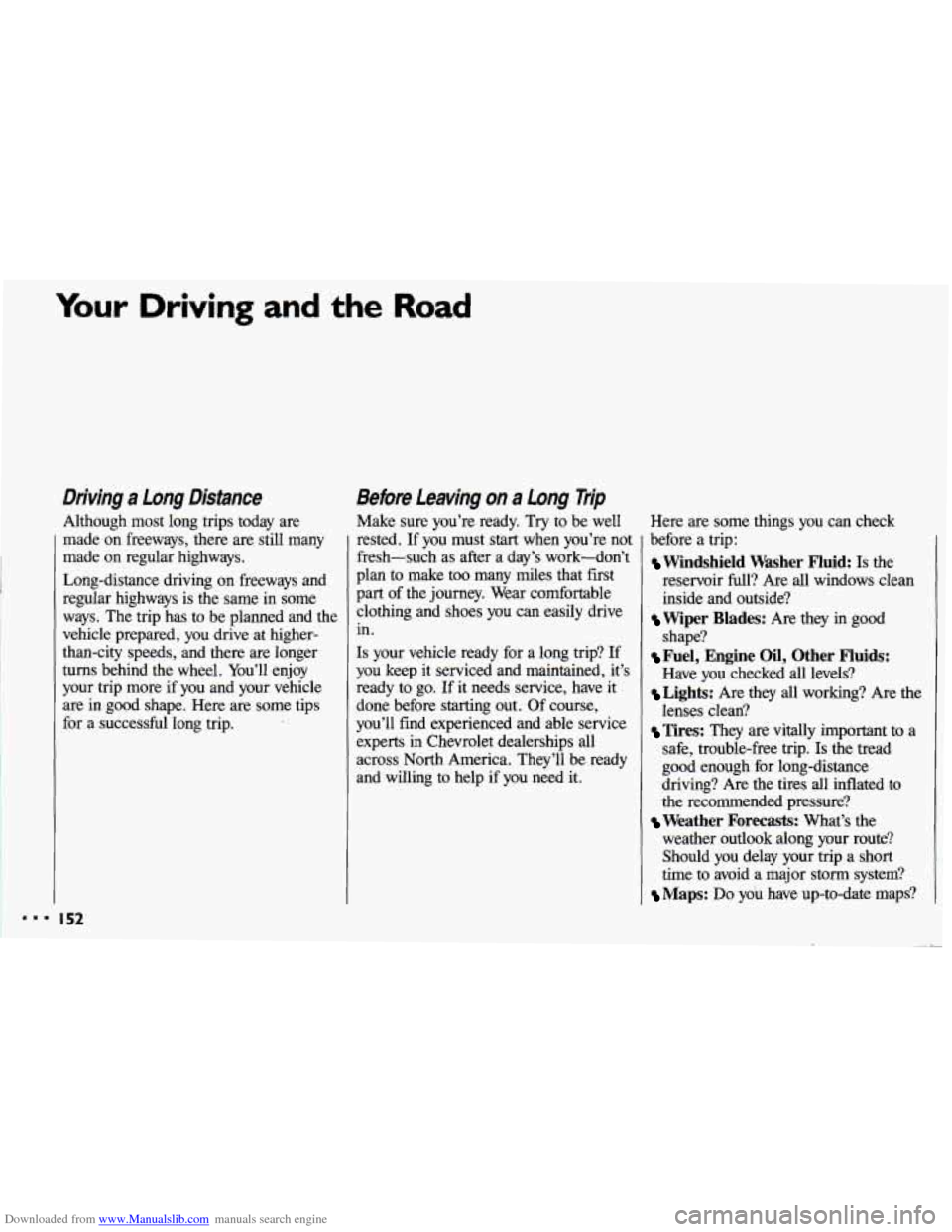
Downloaded from www.Manualslib.com manuals search engine Your Driving and the Road
Driving a Long Distance
Although most long trips today are
made on freeways, there are still many
made on regular highways.
Long-distance driving on freeways and
regular highways is the same in some
ways. The trip has to be planned and the
vehicle prepared, you drive at higher-
than-city speeds, and there are longer
turns behind the wheel. You’ll enjoy
your trip more
if you and your vehicle
are in good shape. Here are some tips
for a successful long trip.
Before Leaving on a Long Trip
Make sure you’re ready. Try to be well Here are some things you can check
rested. If you must start when you’re not
fresh-such as after a day’s work-don’t
plan to make too many miles that
first
part of the journey. Wear comfortable
clothing and shoes you can easily drive in.
Is your vehicle ready for a long trip? If
you keep it serviced and maintained, it’s
ready to
go. If it needs service, have it
done before starting out. Of course,
you’ll find experienced and able service experts
in Chevrolet dealerships all
across North America. They’ll be ready
and willing to help if you need it.
I’
before a trip:
Windshield Washer Fluid: Is the
reservoir full? Are all windows clean
inside and outside?
shape?
Have you checked all levels?
lenses clean? safe, trouble-free trip.
Is the tread
good enough for long-distance
driving? Are the tires all inflated to
the recommended pressure?
weather outlook along your route?
Should you delay your trip a short
time to avoid a major storm system?
Maps: Do you have up-to-date maps?
Wiper Blades: Are they in good
Fuel, Engine Oil, Other Fluids:
Lights: Are they all working? Are the
Tires: They are vitally important to a
Weather Forecasts: What’s the
Page 159 of 308

Downloaded from www.Manualslib.com manuals search engine Torque Lock
(AUTOMATIC TRANSAXLE)
If you are parking on a hill and you
don’t shift
your transaxle into P (Park)
properly, the weight of the vehicle may
put too much force on the parking pawl
in the transaxle. You may find it difficult
to pull the
shift lever out of P (Park).
This
is called “torque lock.” To prevent
torque lock, always be sure to shift into
P (Park) properly before you leave the
driver’s seat.
To find out how, see the
Index under Shiftirtg Into P (Park),
When you are ready to drive, move the
shift lever out
of P (Park) before you
release the parking brake.
If torque lock does occur, you may need
to have another vehicle push yours a
little uphill to take some
of the pressure
from the transaxle,
so you can pull the
shift lever out
of P (Park).
Winter Driving
Here are some tips for winter driving:
Have your Chevrolet in good shape for
winter. Be sure your engine coolant
mix is correct.
Snow tires can help in loose snow, but
they may give you less traction on ice
than regular tires.
If you do not expect
to be driving in deep snow, but may
have to travel over ice,
you may not
want to switch to snow tires at all.
You may want to put winter
emergency supplies in your trunk or
rear area.
Include an ice scraper, a small brush
or broom, a supply of windshield
washer fluid, a rag, some winter outer
clothing, a small shovel, a flashlight,
a
red cloth, and a couple of reflective
warning triangles. And, if you will be
driving under severe conditions,
include a small bag
of sand, a piece of
old carpet or a couple
of burlap bags
to help provide traction. Be sure you
properly secure these items
in your
vehicle.
I57
Page 197 of 308
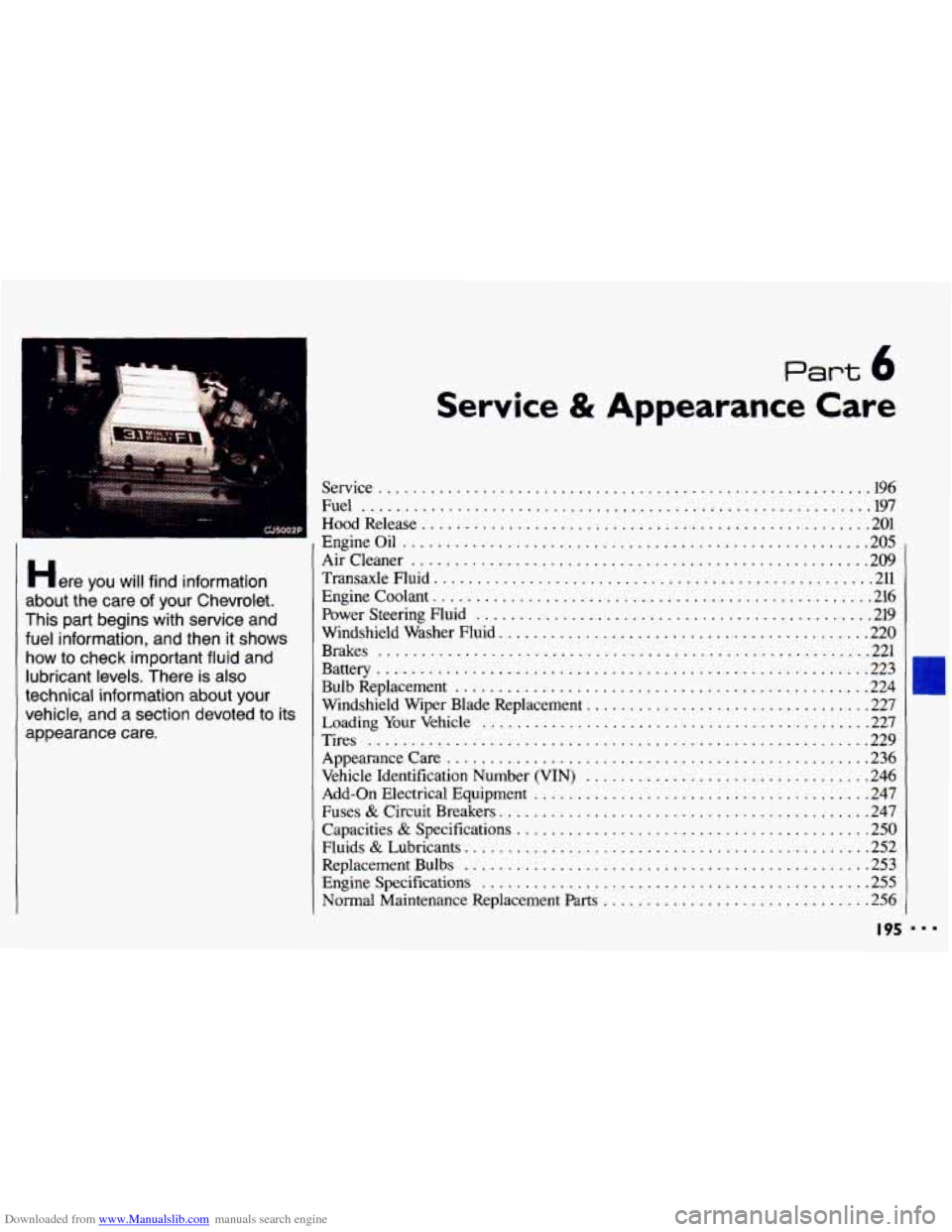
Downloaded from www.Manualslib.com manuals search engine i
.....
.................................. ...................
........ ... . &5
..... ..... .... .. --
' . I .. ~
Here you wit1 find information
about the care
of your Chevrolet .
This part begins with service and
fuel information. and then
it shows
how to check important fluid and
lubricant levels
. There is also
technical information about your
vehicle. and
a section devoted to its
appearance care
.
Part 6
Service & Appearance Care
Service ......................................................... 196
Fuel ........................................................... 197
HoodRelease
.................................................... 201
EngineOil
...................................................... 205
Aircleaner
..................................................... 209
Transaxle Fluid
................................................... 211
Engine Coolant
................................................... 216
Power Steering Fluid
.............................................. 219
Windshield Washer Fluid
........................................... 220
Brakes
......................................................... 221
Battery
......................................................... 223
BulbReplacement
................................................ 224
Windshield Wiper Blade Replacement
................................. 227
Loading
Your Vehicle ............................................. 227
Vehicle Identification Number (VIN)
................................. 246
Add-on Electrical Equipment
....................................... 247
Fuses
& Circuit Breakers ........................................... 247
Capacities & Specifications ......................................... 250
Fluids & Lubricants ............................................... 252
Replacement Bulbs
............................................... 253
Engine Specifications
............................................. 255
Normal Maintenance Replacement
Parts ............................... 256
Tires .......................................................... 229
Appearancecare
................................................. 236
I95
Page 204 of 308
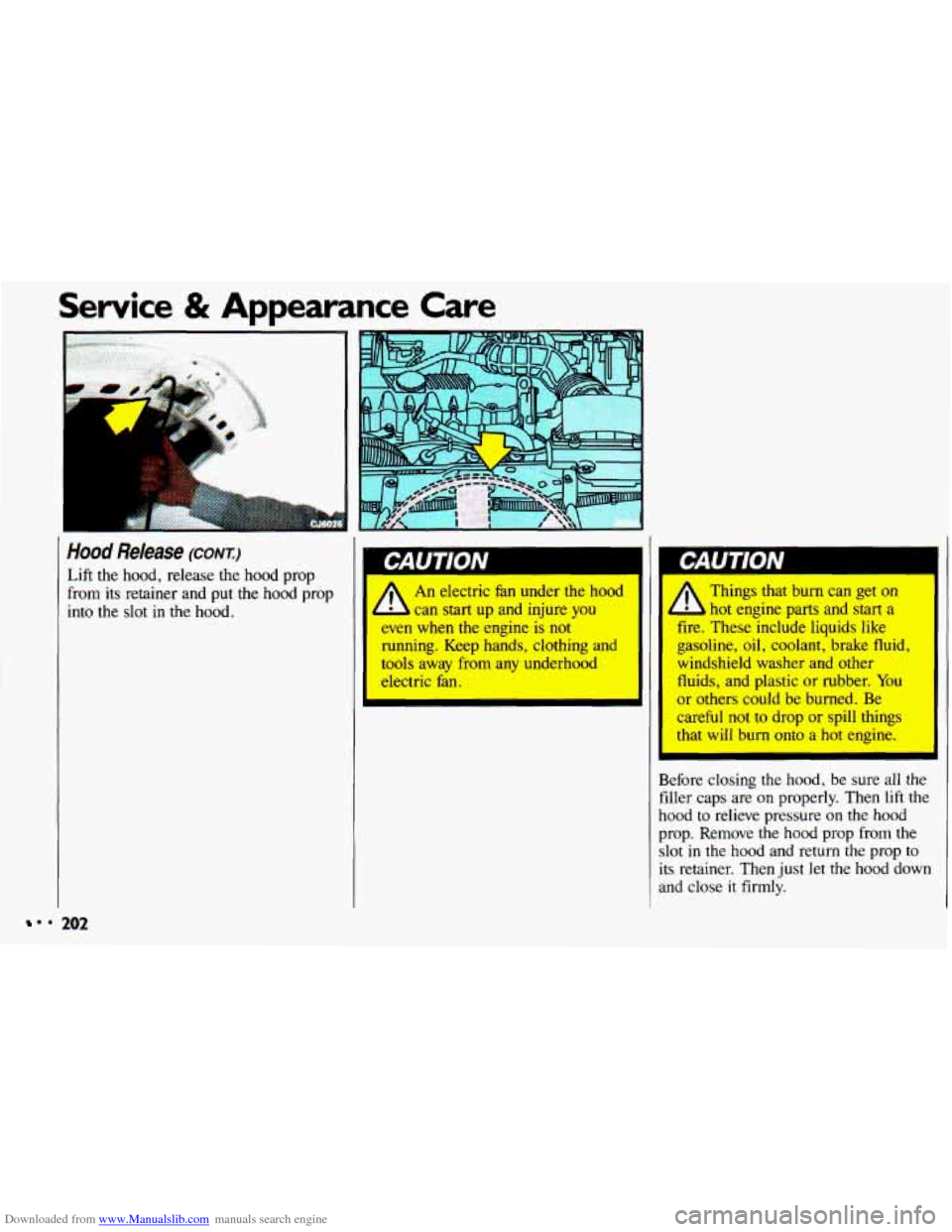
Downloaded from www.Manualslib.com manuals search engine Service & Appearance Care
Hood Release (CONI)
Lift the hood, release the hood prop
from its retainer and put the hood prop
into the slot in the hood.
1 I
I An electric fan under the hood
can start up and injure you
even when the engine is not
running. Keep hands, clothing and
tools away from
any underhood
electric fan.
b
B
fi
h
P
S:
it
a Things that burn can get on
L hot engine parts and start a
me. These include liquids like
gasoline,
oil, coolant, brake fluid,
windshield washer and other
fluids, and plastic or rubber.
You
or others could be burned. Be
careful not to drop or spill things
that will burn onto a hot engine.
lefore closing the hood, be sure all the
iller caps are on properly. Then
lift the
ood to relieve pressure
on the hood
rop. Remove the hood prop from the
lot in the hood and return the prop to
:s retainer. Then just let the hood down
nd close
it firmly.
. 202
Page 205 of 308
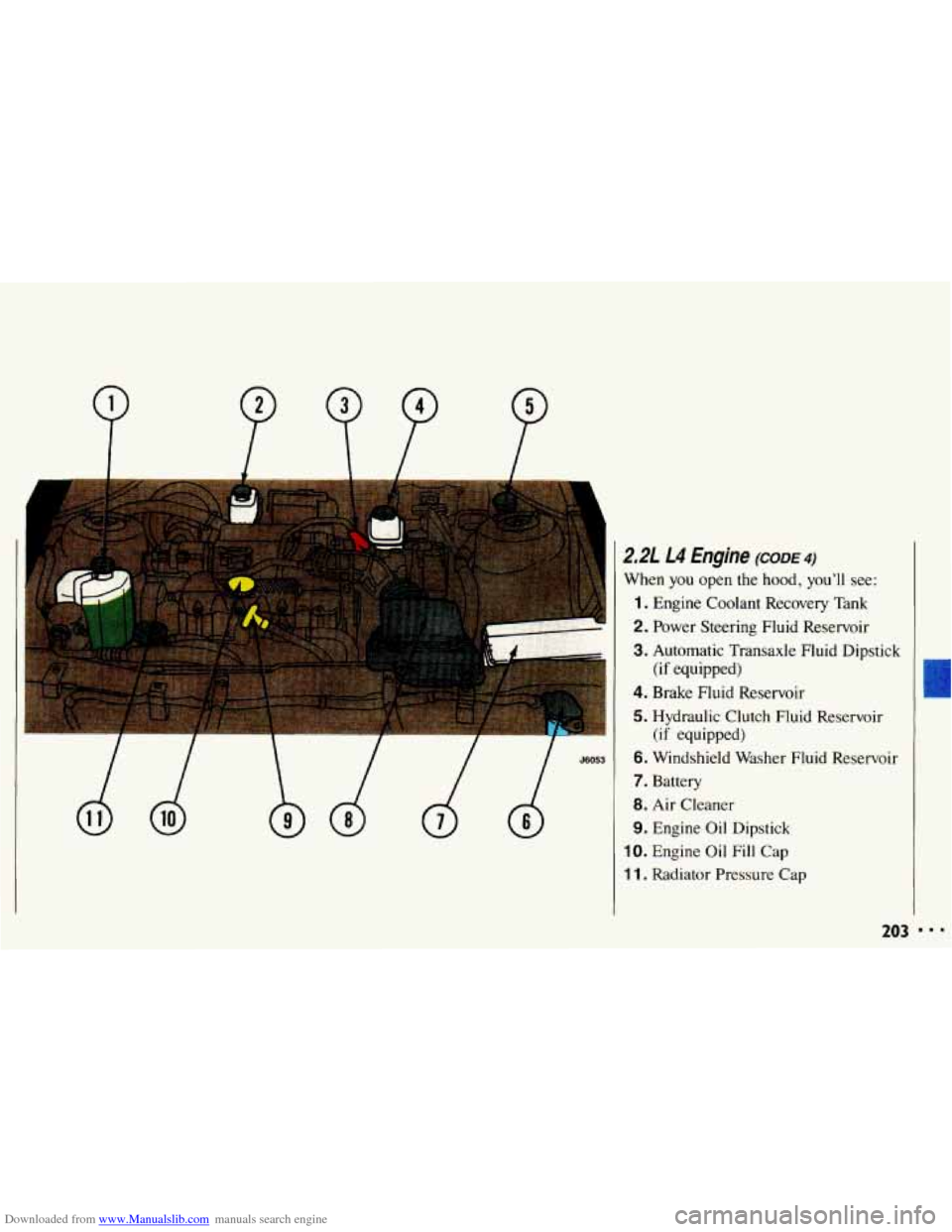
Downloaded from www.Manualslib.com manuals search engine d
56053
2.21 L4 Engine (CODE 4)
When you open the hood, you’ll see:
1. Engine Coolant Recovery Tank
2. Power Steering Fluid Reservoir
3. Automatic Transaxle Fluid Dipstick
4. Brake Fluid Reservoir
5. Hydraulic Clutch Fluid Reservoir
6. Windshield Washer Fluid Reservoir
7. Battery
8. Air Cleaner
9. Engine Oil Dipstick
IO. Engine Oil Fill Cap
1 1. Radiator Pressure Cap
(if equipped)
(if equipped)
203
Page 206 of 308
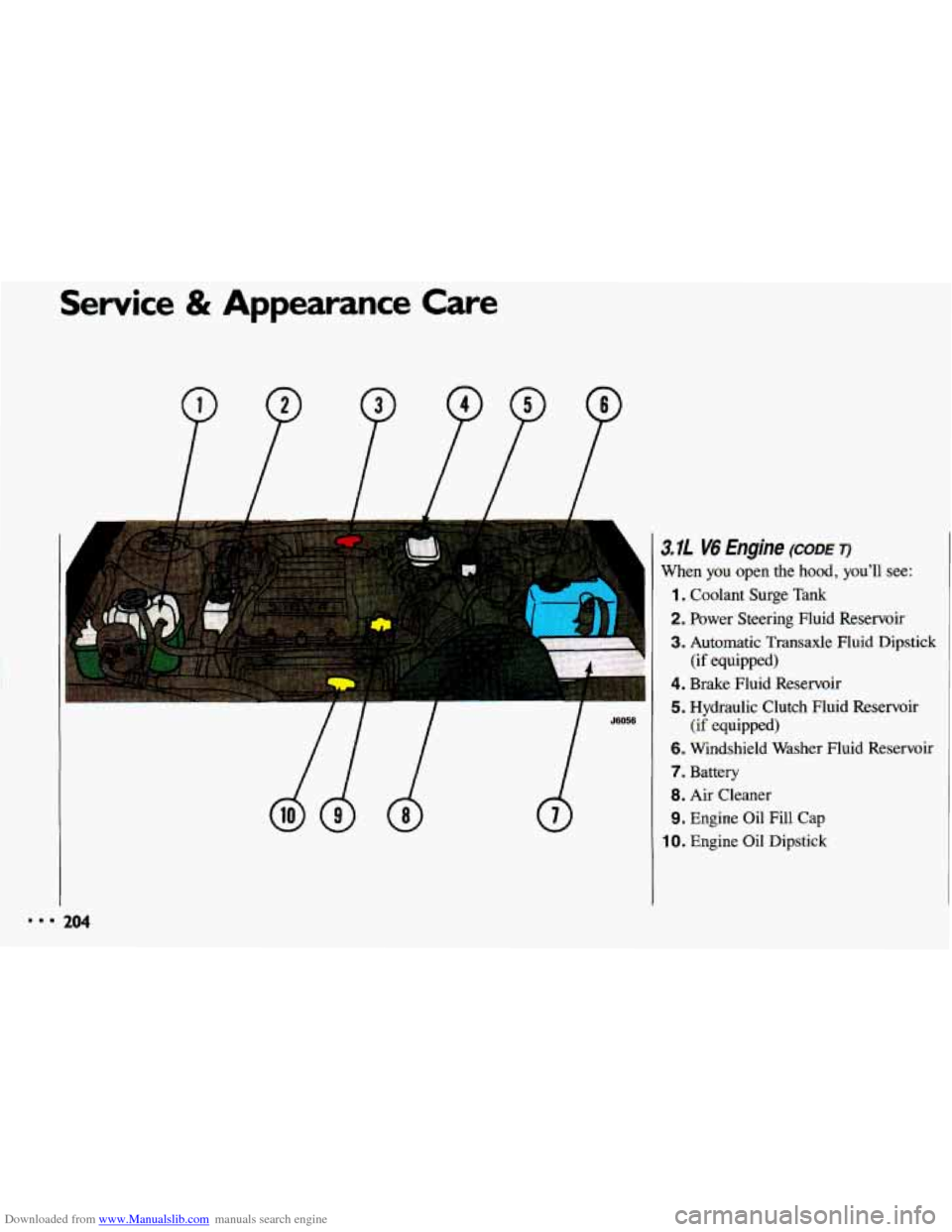
Downloaded from www.Manualslib.com manuals search engine Service & Appearance Care
' 3.11 V6 Engine (CODE T)
1
When you open the hood, you'll see:
1. Coolant Surge Tank
2. Power Steering Fluid Reservoir
3. Automatic Transaxle Fluid Dipstick
4. Brake Fluid Reservoir
5. Hydraulic Clutch Fluid Reservoir
6. Windshield Washer Fluid Reservoir
7. Battery
8. Air Cleaner
9. Engine Oil Fill Cap
10. Engine Oil Dipstick
(if equipped)
(if equipped)
rn 204
Page 222 of 308
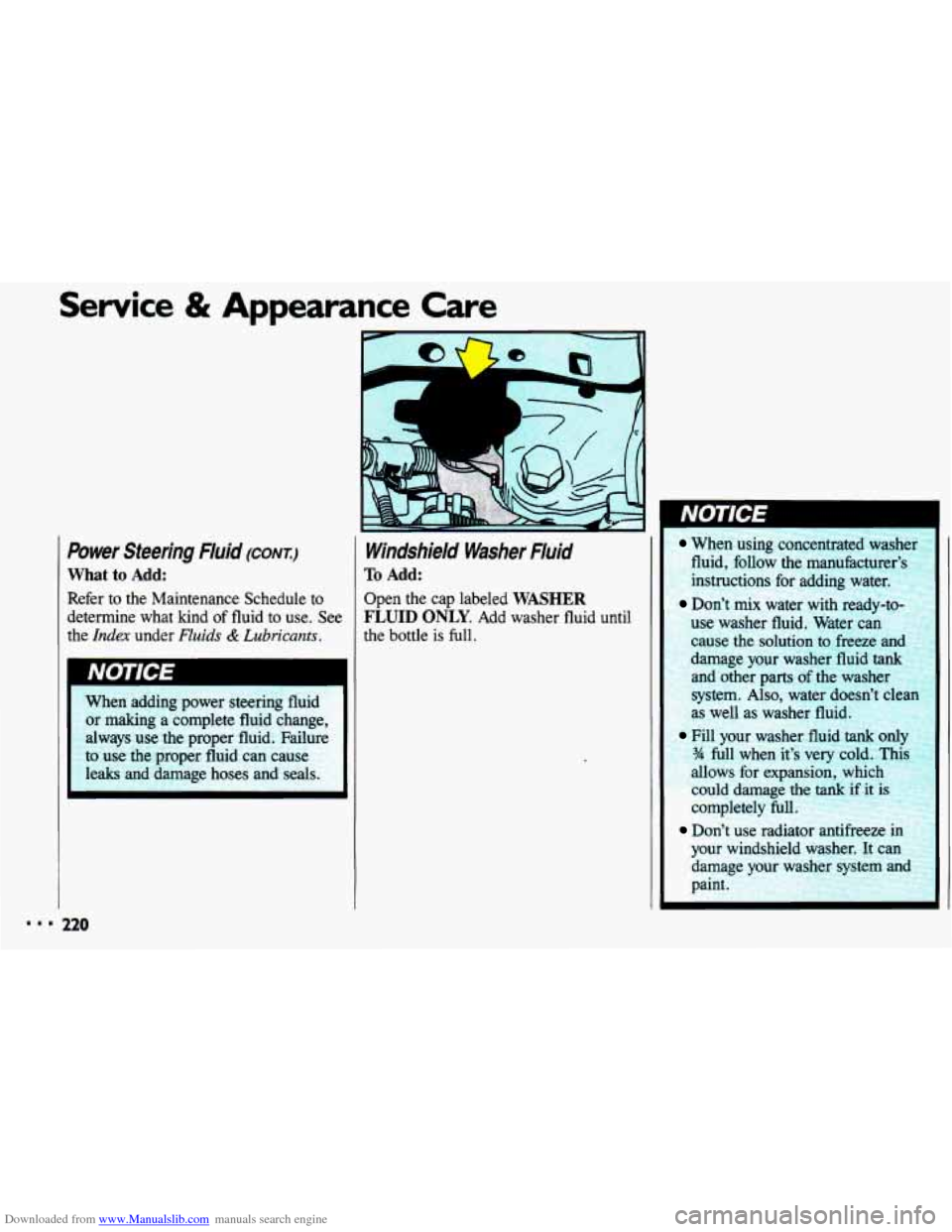
Downloaded from www.Manualslib.com manuals search engine ..I
Service & Appearance Care
Power Steering Fluid (CONT.)
What to Add:
Refer to the Maintenance Schedule to determine what kind of fluid to use. See
the
Index under Fluids & Lubricants.
When adding power steering fluid
or making a complete fluid change,
always use the proper fluid. Failure
to use the proper fluid can cause
leaks and damage hoses and seals.
120
Windshield Washer Fluid
To Add:
Open the cap labeled WASHER
FLUID ONLY. Add washer fluid until
the bottle is full.
When using concentrated washer
fluid, follow the manufacturer’s
instructions for adding water.
Don’t mix water with ready-to-
l15e washer fluid. Water can
use the solution
to freeze and
. .tmage your washer fluid tank
and other parts of the washer
system.
Also, water doesn’t clean
s well as washer fluid.
Fill your washer fluid tank on14
?4 full when it’s very cold. Thir
allows for expansion, which
could damage the
tank if it is
completely
full
Don’t use radiator antifreeze
your windshield washer.
It can
damage your washer system an(
paint.